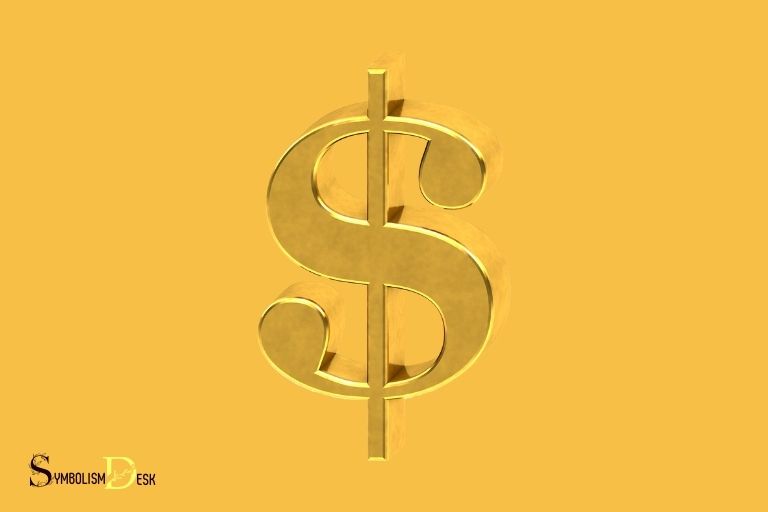What Does the Dollar Symbol Mean? Unit of Currency!
The dollar symbol ($), also known as the dollar sign, represents a unit of currency, most commonly associated with the United States Dollar (USD).
The dollar symbol is derived from the Spanish peso currency sign (Ps), which was used in the Spanish-American colonies.
Through trade and commerce, the symbol made its way to the United States, where it eventually evolved into the current “S” with two vertical lines or a single line crossing through it.
Today, the dollar sign has become a universal symbol for money and is used for various currencies besides the United States Dollar, such as the Canadian Dollar (CAD) and the Australian Dollar (AUD).
In summary, the dollar symbol ($) signifies a unit of currency and is primarily associated with the United States Dollar.
Its origin can be traced back to the Spanish peso currency sign, and over time, the symbol has evolved into the familiar “S” shape with one or two vertical lines.
Although most commonly linked to the United States, the dollar sign is also used to represent other currencies like the Canadian Dollar and the Australian Dollar.
11 Symbolism of the Dollar Sign & their Meaning
| Dollar Symbol | Meaning | Currency | Countries Using The Symbol |
|---|---|---|---|
| $ | Dollar | USD | United States |
| $ | Dollar | CAD | Canada |
| $ | Dollar | AUD | Australia |
| $ | Dollar | NZD | New Zealand |
| $ | Peso | MXN | Mexico |
| $ | Peso | ARS | Argentina |
| $ | Peso | CLP | Chile |
| $ | Peso | COP | Colombia |
| $ | Peso | DOP | Dominican Republic |
| $ | Peso | PHP | Philippines |
| $ | Peso | UYU | Uruguay |
Key Takeaway

Four Facts About: The Meaning of the Dollar Symbol
Origins Of The Dollar Symbol And Its Evolution
The Origins Of The Dollar Symbol Traced Back To Colonial Spanish America
The history of the dollar symbol dates back to the 1770s and is rooted in colonial spanish america.
Here are some key points:
- The spanish empire was one of the most powerful in the world and was known for its extensive silver mining in the new world.
- The spanish peso de ocho, a silver coin also known as the spanish dollar, was widely used as currency in the americas, asia, and europe during the 16th, 17th, and 18th centuries.
- To represent the peso de ocho on their account books and documents, merchants and traders used a symbol similar to the letter ‘s’ with one or two vertical lines through it.
- The symbol evolved over time, with the vertical lines changing to two overlapping ‘s’ shapes, creating the familiar double-stripe symbol we recognize today.
The Evolution Of The Dollar Symbol In The United States
The dollar symbol has undergone several changes since its origins in colonial spanish america.
Here are some key points:
- After the american revolution, the united states established its own currency, adopting the spanish dollar as its base unit and incorporating the double-stripe symbol.
- The design of the double-stripe symbol varied widely in the u.s. until the late 19th century, with multiple versions featuring varying numbers of vertical lines or stars.
- In 1786, the u.s. congress designated the dollar as the official currency of the united states.
- In 1869, the u.s. Adopted a standardized version of the dollar symbol with two vertical lines, which has remained in use to this day.
- The dollar symbol has become a ubiquitous symbol of u.s. economic power and influence, recognized and used around the world.
The Significance Of The Dollar Sign
The dollar sign is a symbol recognized worldwide, used extensively in transactions and commerce.
Have you ever wondered what the dollar sign represents, or its origin?
This article will guide you through all the details to give you an in-depth understanding.
The use of the dollar sign in banking, commerce, and finance:
- The dollar sign represents the currency of the united states and is used as a shortening of the word “dollars.” It is used globally and features on most currencies.
- The dollar sign is a widely recognized symbol used in banking, commerce, and finance to emphasize the dollar’s worth.
- In finance, the dollar sign adds emphasis to the amount being discussed that relates to revenue, investment, or loan amounts, and precisely indicates the currency involved.
The historical and cultural significance of the dollar sign:
- The dollar sign has a rich history, originating from spanish america in the 16th century and represented as a column or a pillar. It also resembles the figure “8” with a line running across it.
- There are various theories on the exact origin of the dollar symbol. One theory explains that it is derived from the spanish ‘pieces of eight’ coin that was once circulate in spain, which was also known as peso de ocho, which later evolved into the u.s. dollar sign $.
- Additionally, it has been suggested that the dollar sign derives from the initials ‘u’ and ‘s’ as it represents the united states’ currency.
The dollar sign is a crucial symbol that plays a significant role in banking, commerce, and finance globally. Its historical and cultural significance can also be traced back to ancient times.
Understanding the dollar sign’s significance provides context and insight into the global financial system and the importance of currency symbolism.
Understanding The Currency Code For The Dollar Sign
You might have seen the “$” symbol almost everywhere – on your bank statement, shopping receipts, or news articles about the economy.
But, have you ever wondered what it means precisely? We’ll help you understand the currency code for the dollar sign.
The Code For The Dollar Sign And Its Use In Global Commerce
The dollar sign represents several currencies worldwide, such as the us dollar, canadian dollar, and australian dollar. Each currency has its specific currency code, assigned by the international organization for standardization (iso).
Let’s take a look at the codes for some of the world’s most traded currencies:
- Us dollar – usd
- Canadian dollar – cad
- Australian dollar – aud
- Euro – eur
- Japanese yen – jpy
These codes are critical to ensure accuracy when quoting exchange rates and calculating currency conversions.
Some points to remember about currency codes are:
- Codes are always written in uppercase letters.
- Three-letter codes are divided into two parts- the first 2 leters represent the country code, and the third letter represents the currency. For example, aud represents the australian dollar because “a” stands for australia and “d” stands for dollar.
- In the case of the us dollar, “us” represents the country code, and “d” stands for dollar.
Exchange Rates, Currency Symbols, And The Dominance Of The Dollar
The exchange rate is the value of one country’s currency concerning another. The currency rate system is quite complex, and multiple factors influence it.
However, here is what you should know about exchange rates:
- The us dollar is the most dominant currency in global commerce, and most exchanges use the us dollar as a benchmark.
- Currency symbols help identify a currency’s value in the market. For instance, the euro symbol (€) signifies a high-value currency, while the chinese yuan symbol (¥) represents a low-value currency.
- Fluctuations in currency exchange rates can impact trade between countries, as it affects the prices of imported and exported goods and services.
The dollar sign represents multiple types of currencies worldwide, and each currency has a specific currency code.
These codes are crucial when converting currencies, calculating exchange rates, and ensuring accuracy in global commerce.
Furthermore, the us dollar’s dominance in commerce and currency symbols’ impact on exchange rates and trade cannot be ignored.
The Use Of The Dollar Symbol In Popular Culture
Many people recognize the dollar symbol due to its ubiquity in modern society. It is a symbol that many of us encounter every day, whether in the context of finance or simply in our daily lives.
The Use Of The Dollar Sign In Music, Film, And Television
The dollar sign has been frequently used in popular music, either as a symbol of wealth or as a way to criticize consumer culture.
Examples include:
- Notorious b.i.g. ‘s “mo money mo problems”
- Pink floyd’s “money”
- Lana del rey’s “national anthem”
- Cardi b’s “money”
The dollar symbol has also made appearances in many films and tv shows, typically featuring wealth-driven or finance-centric storylines.
Examples include:
- “wall street”
- “the wolf of wall street”
- “billions”
- “succession”
- In all of these cases, the use of the dollar symbol is representative of the wealth and power associated with the american economic system.
Pop Culture And The Redefinition Of The Dollar Sign’s Meaning
While the dollar sign has long represented wealth and power, its usage in pop culture has also evolved to criticize consumerism and individualism.
Examples include:
- Madonna’s “material girl”
- Kanye west’s “new slaves”
- Fka twigs’ “$$$”
- The popularity of these songs demonstrates a shift in public opinion towards a greater awareness of consumer culture and income inequality. The dollar symbol is no longer just a symbol of wealth, but also a symbol of greed and corruption within capitalist society.
- Pop culture has redefined the dollar sign, transforming it from a symbol of american prosperity to a symbol of criticism and reflection. As such, the dollar sign has become a powerful tool for artists and creatives, who use it to comment on, and critique, the society in which we live.
The dollar sign’s meaning has changed significantly, reflecting the changing attitudes towards wealth and consumer culture.
Its use in popular media highlights the american dream and the societal issues that have arisen from it, making it both a powerful cultural symbol and a tool for artists to express their viewpoints.
The Symbolism Of The Dollar Sign
The american dollar symbol, denominated as $, is a universally recognizable symbol that has a significant impact on consumer behavior.
But what does the symbol represent, and why does it have so much power over our spending decisions?
In this section, we will explore the psychology behind the symbolism of the dollar sign and its impact on consumer behavior.
The Association Between The Dollar Sign And Wealth, Prosperity, And Power.
- The dollar sign is a symbol of wealth and power in the american culture.
- It is commonly used to represent money, commerce, and finance.
- It has a strong association with prosperity, luxury, and status.
- The symbol has been used in popular culture to evoke feelings of success and achievement.
- In the minds of consumers, the dollar sign represents the ability to acquire goods and services, live a comfortable lifestyle, and achieve financial independence.
The Psychological Impact Of The Dollar Sign On Consumer Behavior.
- The sight of a dollar sign can trigger a pleasure response in the brain, releasing dopamine, the chemical associated with pleasure and reward.
- The symbolism of the dollar sign can influence consumer behavior, making them more likely to spend money.
- The dollar sign can also create a sense of urgency and excitement around purchasing decisions.
- Consumers tend to focus more on the symbolic value of the dollar sign rather than its real value, leading to impulsive buying decisions.
- Marketers use the dollar sign as a powerful visual cue to create a sense of value and affordability for their products.
The dollar sign holds significant symbolism in american culture, representing wealth, prosperity, and power.
Its impact on consumer behavior cannot be overstated, as it has the power to influence purchasing decisions and create a sense of urgency around products and services.
Understanding the psychology behind the symbolism of the dollar sign can help businesses create effective marketing strategies and tap into the power of this universally recognized symbol.
The Controversy Surrounding The Dollar Symbol
Though the dollar sign is widely accepted as a symbol for a currency, it remains a subject of ongoing debate and criticism.
Criticism Of The Dollar Symbol As A Representation Of Capitalist Values
The dollar sign represents the value of a currency, but critics argue that it also represents the values of capitalism.
Some arguments against the dollar sign include:
- The symbol reinforces the focus on profits at the expense of people.
- It contributes to the concentration of wealth in the hands of a few.
- The dollar sign excludes those who don’t have access to money.
The Ongoing Debate About The Impact Of The Dollar Sign On Society
Discussions surrounding the dollar sign’s impact on society continue to rage on.
Some aspects being debated include:
- The interplay between capitalism, inequality, and the dollar sign
- Whether or not the symbol should be replaced with something more neutral or inclusive
- The relationship between the dollar sign and the world economy
As the dollar sign remains a widely recognized symbol used around the world, it is clear that this debate is far from over.
Comparison Of Different Currency Symbols
The dollar symbol is ubiquitous in today’s world of globalized commerce. Many of us unconsciously associate it with america, where the currency reigns supreme.
However, currency symbols around the world are much varied, each representing their country’s unique history and culture.
In this section, we’ll delve into the history, origin, and symbolism of different currency symbols. We’ll also explore how these currencies have influenced global economics and politics.
The Origin, Significance, And Symbolism Of Different Currency Symbols Around The World.
Currency symbols have been around for hundreds of years, representing their nation’s economy, culture, and history.
Here are some interesting tidbits about some familiar currency symbols from around the world:
- Dollar ($): The dollar symbol dates back to the spanish empire, where it was regularly used when referring to pesos. The two pillars on either side of the “s” represent the mediterranean sea, which played a significant role in spain’s economy.
- Euro (€): Designed in 1996, the euro is a fusion of the greek letter epsilon and the letter “e.” the two lines that cross the symbol represent stability in the european economy, while the twelve stars reflect the number of countries in the european union at the time.
- Japanese yen (¥): The yen symbol features a horizontal stroke through the middle of the symbol, representing stability and balance. The two vertical bars on either side represent the influence of confucianism on japanese culture.
How Different Currencies Have Influenced Global Economics And Politics.
Currencies have always played a vital role in global economies and politics.
Here are some ways in which they’ve impacted the world beyond their borders:
- American dollar: Being the world’s dominant currency, the american dollar plays a crucial role in global trade, commodity pricing, and international lending. The us dollar’s strength and supremacy allowed america to establish itself as the largest global superpower today.
- Chinese yuan: The chinese yuan’s growing strength has significant implications for global economics and politics as china attempts to expand its influence overseas and reduce its reliance on the us dollar.
- European euro: The euro represents one of the most significant economic and political integrations in history. It has given europe immense financial and political power, from influencing global trade deals to reinforcing european unity.
Currency symbols are more than just signs we use to represent value. They tell stories of the places they come from, and their influence extends far beyond national borders. For instance, the dollar sign ($) has become a global symbol of commerce and economic power, while the euro (€) represents unity and cooperation among European nations. These symbols are deeply tied to the meaning of national symbols, reflecting cultural identity and historical significance. In many ways, they transcend their practical use, becoming icons of economic ambition and collective heritage.
By understanding their history and significance, we can appreciate the role currencies have played in global developments and better understand their impact today.
The Future Of Currency Symbols
What Does The Dollar Symbol Mean
The dollar symbol, $, is recognized worldwide as the symbol for the united states dollar currency.
Its origin is rooted in the spanish peso, which was the primary currency used throughout the americas. However, now the dollar symbol is much more than just a symbol for a currency.
It has become a symbol of worldwide trade and commerce. The dollar symbol is an essential component in the growth of globalisation.
The Impact Of Globalisation And Technological Advancements On The Future Of Currency.
The ongoing influence of globalisation is transforming every aspect of business, including currency.
The interconnectedness of the world economy has occasionsed a lessening of national borders, resulting in the growth of global trade.
It has increased the requirement for currencies that are straightforward, simple, and easy to use.
Throughout the years, currencies such as the us dollar and the euro have grown in popularity due to their ease of use.
With technological advancements, however, it is anticipated that cryptocurrencies will become more common.
This new form of currency is free from government control, which could lead to more unstable financial markets, whilst at the same time, promoting a more decentralized international economy.
The Potential Emergence Of New Currency Symbols And Their Meanings.
As globalisation and technological progress carry on at this speed, it is anticipated that new currencies will emerge, and with them, new currency symbols.
As we have seen throughout history, currency symbols, such as the dollar, often take on a much broader meaning beyond the currency itself, portraying wider values and political ideologies.
It is likely the new currency symbols will also adopt such values and political opinions.
Many believe that the rise of cryptocurrency could lead to the creation of new currencies and currency symbols.
These new currencies could be based on local areas and with a new symbol to reflect their roots.
Alternatively, some believe that there will be a merging of current currencies or even a single universal currency altogether.
This would result in a new universal symbol, presented as part of a shared, worldwide understanding of current currency and commerce.
Overall, with the continuing growth of globalisation and technological advancements, we can expect to witness a shift from traditional currencies towards new forms of currency, including cryptocurrencies, expected to change the way we look at all currency symbols.
Recap Of The Dollar Symbol’s Meaning
The dollar symbol ($), also known as the american dollar sign, is one of the most recognizable symbols worldwide.
The symbol’s origin is a topic of debate, but the most widely accepted explanation is that it evolved from abbreviating the word ‘peso.’
Despite its mysterious past, the dollar symbol has come to represent much more than just a currency.
Summary Of How The Meaning Of The Dollar Symbol Evolved Over Time
- According to one hypothesis, the dollar sign evolved from abbreviating the word ‘peso.’ In the late 1700s, spanish dollars were commonly used in america, and the abbreviation ‘ps’ or ‘psos’ was used to indicate them.
- Another theory suggests that the symbol evolved from the letters ‘u’ and ‘s,’ which represented the united states on currency in the late 1700s.
- By the mid-1800s, the dollar sign began to appear on official us currency and spread globally thanks to america’s economic and political power.
- Today, the dollar symbol represents much more than just the us currency and is widely used in commerce worldwide.
A Reflection On The Importance Of The Dollar Symbol In Modern Society
- The dollar sign has become a universal symbol that represents commerce, trade, and modern capitalism.
- The symbol is used in international trade and finance and serves as a measurement of value for goods, services, and assets worldwide.
- The dollar symbol also plays an important role in the global economy, affecting exchange rates, international trade policies, and monetary policies.
- The idea of the dollar as a symbol of prosperity and success has become embedded in american culture, and the dollar sign has become an icon of american capitalism and entrepreneurship.
The dollar symbol’s meaning has evolved over time, and it has become an essential symbol of commerce, trade, and economic power worldwide.
Its importance in modern society is undeniable, and it serves as a universal measurement of value for goods, services, and assets worldwide.
What Does the Egyptian Owl Symbolize in Terms of Wisdom?
The egyptian owl symbolism explained in terms of wisdom reveals the significant role this majestic bird played in ancient Egyptian culture. Considered a symbol of wisdom, the owl represented knowledge, learning, and intuition. With their ability to see in the dark, owls were revered as wise guides, enlightening the Egyptians about the mysteries of life and the spirit realm.
FAQ About What Does The Dollar Symbol Mean?
What Is The Origin Of The Dollar Symbol?
The dollar symbol evolved from the spanish peso sign, which was written as ‘ps. ‘
Why Is The Dollar Symbol An S With A Vertical Line Through It?
The dollar symbol was originally an abbreviation of the spanish peso, which was written as ‘ps. ‘ Over time, it evolved into the current s shape with a vertical line.
What Does The Dollar Symbol Represent?
The dollar symbol represents the us dollar, which is the official currency of the united states. It is also used to represent other currencies that are pegged to the usd.
What Is The Difference Between The Dollar Symbol And The Cent Symbol?
The dollar symbol ($) represents dollars and the cent symbol (¢) represents cents. One dollar is equivalent to 100 cents.
Is The Dollar Symbol Used In Other Countries Besides The Us?
Yes, the dollar symbol is used in countries such as australia, canada, new zealand, and singapore, among others. However, the value represented by the symbol may vary depending on the country’s currency.
Conclusion
From the above discussion, we can conclude that the dollar symbol has a long and fascinating history that spans many centuries.
Initially, the symbol was used to denote weight and not currency. However, with the emergence of global trade and commerce, the dollar symbol evolved to signify the united states currency.
Still, with the rise of digital currencies and electronic payments, the dollar symbol has taken on a new meaning as a symbol of value and exchange.
Today, the dollar symbol is a fundamental part of international trade and commerce, and it is essential to understand its meaning and significance.
Finally, we can say that the power and significance of the dollar symbol will continue to evolve and adapt as the world of finance and commerce continues to progress.
As always, understanding the history and context of the symbol is essential for anyone attempting to navigate the complex world of financial transactions and currency exchange.






